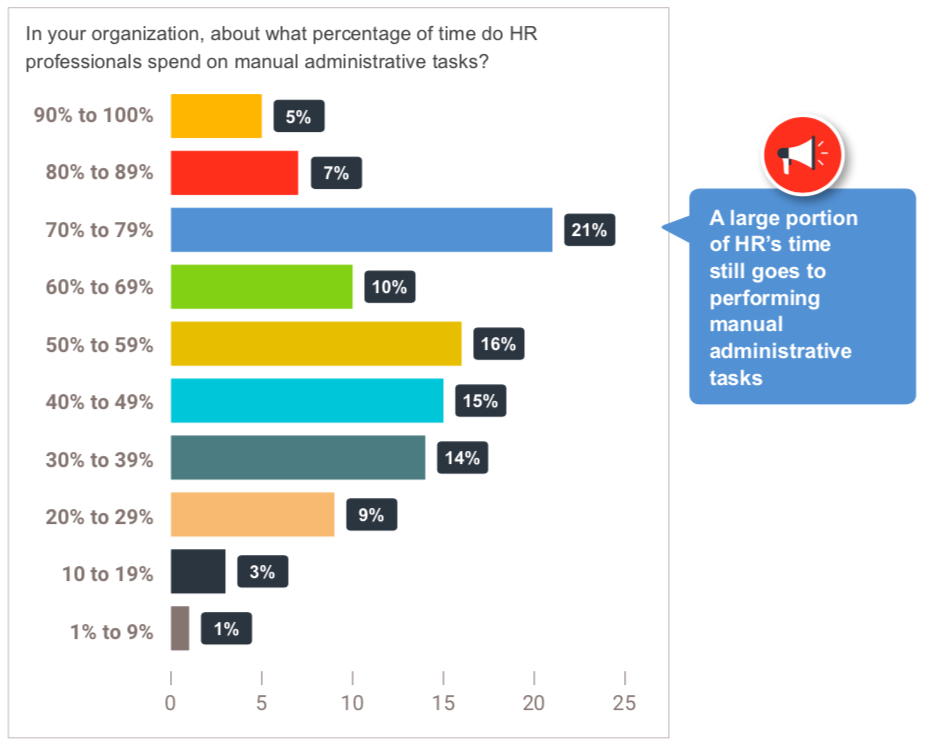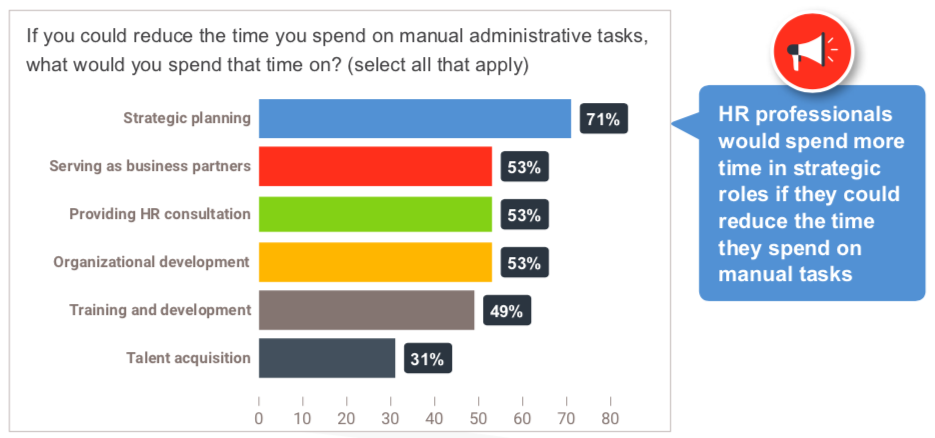In 2018, HR.com and Iron Mountain conducted a study on The State of HR Automation in Mid-Sized Organisations. Findings reveal that most HR departments are STILL bogged down by manual administrative tasks. A majority of respondents (59%) said the HR professionals in their organisation spend over half their time on manual administrative tasks. This is supported by other HR.com research. In their Advancing HR Function study, half of respondents predicted that 'HR will be transformed into a much more strategic function as administrative duties are automated or outsourced to others.' And yet, despite all the advancements in technology, HR often still finds itself trying to balance two roles: Rule-driven bureaucrat and strategically motivated talent manager. If HR Professionals want to take a leading role in redesigning work, such a redesign needs to amplify efficiencies through automation so as to have the bandwidth to become a more strategic function. In this blog we explore where HR automation can produce the greatest efficiency gains across the employee lifecycle.
HR Automation in Mid-Sized Organisations
If you're an HR Professional in a mid-sized organisation being asked to do more with less whilst at the same time ensuring efficiency, compliance, engagement and brand reputation, you're no doubt feeling the pinch. In The State of HR Automation report, it is clear that many HR Professionals working in the mid-sized space are missing out on the benefits that intelligent HR automation can provide.
Outlined below are the headlines from the report.
HR automation is well-established in some mid-sized organisations, but most are not yet highly automated:
-
A substantial majority of participants (64%) said less than half of their HR processes are currently automated.
-
Only about a third of HR departments in mid-sized organisations consider themselves to have highly automated HR process automation (that is, a rating of 7 or higher on a 10-point scale). However, 34% have low automation, scoring a 4 or lower on the scale. The rest were somewhere in between.
-
94% of participants said their organisation intends to automate more HR processes in the future.
Some HR processes are much more likely to be automated than others:
-
The HR processes most frequently automated by mid-sized organisations represent some of the most mature HR technology solutions available: time and attendance (71%), payroll management (69%) and benefits (56%).
-
Respondents were most likely to say that onboarding will be the HR process their organisations are most likely to automate in the next two years.

Organisations adopt automation to increase effectiveness and efficiency, but many organisations said a lack of resources hinders their progress:
-
More automation is the option of choice among HR professionals as a way of increasing HR’s efficiency. HR professionals are not very supportive of outsourcing HR services to increase efficiency.
-
The single largest perceived barrier to HR automation is a lack of resources. Participants said outdated technology is the next most significant barrier to HR process automation. In some cases, respondents may not be aware of the cost-effective gains in productivity from HR automation using cloud-based solutions.
HR automation seems to result in a number of advantages, including higher productivity and the ability to spend more time on strategic matters:
-
Respondents from highly automated HR departments are twice as likely to say HR enjoys above-average productivity when compared to HR departments with low automation.
-
HR professionals would spend more time on strategic HR and business initiatives if they could reduce the burden of performing manual administrative tasks. Nearly 70% of the participants said they would have more time for strategic planning, and 64% said they could serve as business partners if the time spent on manual administrative tasks could be reduced.

Highly automated HR departments tend to be more productive:
-
Overall, 34% of participants said their organisations perform above average in terms of HR productivity. Respondents from Highly Automated HR Departments were almost twice as likely as respondents from the least automated HR Departments to say that the HR productivity in their organisation was above average (44% to 23%).
-
This finding further supports the idea that greater HR automation exerts an influence in raising HR productivity. In fact, we’ve already seen findings and data that support this connection. For instance, 78% of all participants told us further HR automation would boost HR’s productivity. It’s important to note that the data does not prove a causative link between automating HR processes and productivity, but it does suggest some connection or influence.
Highly automated HR functions tend to be more effective:
-
Overall, 31% of all participants said their mid-sized organisations perform above average in terms of HR effectiveness. Respondents from Highly Automated HR Departments were considerably more likely than those from the Least Automated HR Departments to say they enjoyed above average HR effectiveness (38% to 25%). The difference here was, however, not as large as with productivity.
Making a Business Case: Illustrating the Benefits of an HR Automation Investment
Let’s use the example of an HR professional trying to determine whether it makes sense to automate certain tasks in the onboarding process. Let's assume the following facts for the organisation: 90% of the entry-level hires take an average of 10 weeks to reach full productivity.
At such an organisation, you can demonstrate that the current out-of-pocket, hard costs to onboard each new hire is $5,000. You can also demonstrate that, with automation, the costs can be dropped to $4,000 per new hire, a 20% cost saving.
But these savings occur before improved productivity is taken into consideration. You could also illustrate that each entry-level new hire generates $10,000 per week in gross revenue when they reach full productivity but only $6,000 per week while they are learning. Let’s say an automated system will allow new hires to reach full productivity in 6 weeks as opposed to the usual 10-week process. The gain with this productivity is $4,000 per new hire per week for four weeks, which amounts to $16,000.
Now the business shows a $1,000 cost savings per new hire, which is good, but it also realises a gain in productivity of $16,000.
Onboarding ROI
|
Cost Saved per new hire |
$1000 |
|
Productivity gained |
$16,000 |
|
Automation investment per new hire |
($500) |
|
TOTAL ROI per new hire |
$16,500 |
Other Benefits of Using Automated Employee Onboarding
Bersin by Deloitte's research illustrates that the benefits of using a deliberate, well-designed onboarding process delivered via an automated employee onboarding software solution are substantial. The goal of onboarding is compelling – to get the employee engaged and productive in the company and its culture as rapidly as possible. It is also the one chance to impress the employee and reinforce his / her decision to join the company – a kickstart to employee engagement. Deloitte believes that employers using a structured onboarding program can realise these benefits:
-
Employees are more engaged (49 percent).
-
More employee confidence (46 percent).
-
Employees have greater trust in the organisation (45 percent).
-
Greater efficiencies (44 percent).
-
Higher productivity (42 percent).
-
Higher morale (38 percent).
-
Lower employee turnover (31 percent).
-
Contributes to meeting revenue targets (21 percent).
According to a study by the Wynhurst Group, when employees go through structured onboarding, they are 58% more likely to remain with the organisation after three years. If you want to find out more about how to design an onboarding experience that makes employees want to stay with your organisation, take a look at our How Your Business Does Employee Onboarding Is How It Does Everything Blog.
Have You Automated Your Organisation's Employee Onboarding Process?
Onboarding will become one of the most commonly automated HR processes in the near future, not just because automation provides a great return on investment. It also enhances the engagement of your new hires as well as increasing the likelihood that they will stay with you long term. During onboarding there is a barrage of paperwork and numerous documents to sign and complete by both employee and employer. Can these effectively be moved to an automated process so that valuable interpersonal time with new hires can be used for cultural orientation, introductions to key team members, training, etc.? Moreover, can that interpersonal time be effectively tracked so that HR has an accurate idea of what the new employee does and doesn’t know?
The answers is yes.
Onboarding is just one aspect of the employee lifecycle where there are efficiency and engagement gains to be found. If you automate the the right tasks throughout the six key phases of the employee lifecycle, individuals and organisations stand to benefit in multiple ways.
We hope you've extracted some wisdom and value from this 5 blog series designed to give HR Professionals a toolkit that helps in the decision making process about whether to to automate or not to automate. If you're ready to discover more about how automation can improve your organisation at every stage of the employee lifecycle? Simply click on the link to explore that blog.
Is your business ready to leverage HR automation in your workplace so that you can free your employees from repetitive, manual tasks forever? To help you leverage the benefits of automation we've made our Employee Onboarding software free. FOREVER. To try it for yourself, simply click on the button below.


